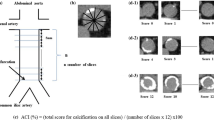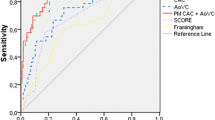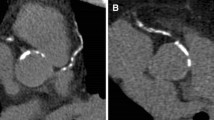Abstract
Objectives
To assess the value of a CT-based abdominal aortic calcification (AAC) score as a surrogate marker for the presence of asymptomatic coronary artery disease (CAD).
Methods
The AAC scores of 373 patients without cardiac symptoms who underwent both screening coronary CT angiography and abdominal CT within one year were calculated according to the Agatston method. Logistic regression was used to derive two multivariate models from traditional cardiovascular risk factors, with and without AAC scores, to predict the presence of CAD. The AAC score and the two multivariate models were compared by calculating the area under the receiver operating characteristic curve (AUC) and the net reclassification improvement (NRI).
Results
The AAC score alone showed a marginally higher AUC (0.823 vs. 0.767, P = 0.061) and significantly better risk classification (NRI = 0.158, P = 0.048) than the multivariate model without AAC. The multivariate model using traditional factors and AAC did not show a significantly higher AUC (0.832 vs. 0.823, P = 0.616) or NRI (0.073, P = 0.13) than the AAC score alone. The optimal cutoff value of the AAC score for predicting CAD was 1025.8 (sensitivity, 79.5 %; specificity, 75.9 %).
Conclusions
AAC scores may serve as a surrogate marker for the presence or absence of asymptomatic CAD.
Key Points
• Severe vascular calcification indicates a high probability of coronary artery disease.
• Vascular calcification in the abdominal aorta can be quantified by computed tomography.
• Abdominal CT could lead to early detection of asymptomatic coronary artery disease.


Similar content being viewed by others
Abbreviations
- CAD:
-
coronary artery disease
- CAC:
-
coronary artery calcification
- AAC:
-
abdominal aortic calcification
- CCTA:
-
coronary CT angiography
- ROC:
-
receiver operating characteristic
- NRI:
-
net reclassification improvement
- AUC:
-
area under the curve
References
Finegold JA, Asaria P, Francis DP (2012) Mortality from ischaemic heart disease by country, region, and age: Statistics from World Health Organisation and United Nations. Int J Cardiol 168:934–945
Franklin BA, Cushman M (2011) Recent advances in preventive cardiology and lifestyle medicine: a themed series. Circulation 123:2274–2283
Myerburg RJ, Kessler KM, Castellanos A (1993) Sudden cardiac death: epidemiology, transient risk, and intervention assessment. Ann Intern Med 119:1187–1197
Budoff MJ, Achenbach S, Blumenthal RS et al (2006) Assessment of coronary artery disease by cardiac computed tomography: a scientific statement from the American Heart Association Committee on Cardiovascular Imaging and Intervention, Council on Cardiovascular Radiology and Intervention, and Committee on Cardiac Imaging, Council on Clinical Cardiology. Circulation 114:1761–1791
Polonsky TS, McClelland RL, Jorgensen NW et al (2010) Coronary artery calcium score and risk classification for coronary heart disease prediction. JAMA 303:1610–1616
Mautner GC, Mautner SL, Froehlich J et al (1994) Coronary artery calcification: assessment with electron beam CT and histomorphometric correlation. Radiology 192:619–623
Sutton Tyrrell K, Kuller LH, Matthews KA et al (2002) Subclinical atherosclerosis in multiple vascular beds: an index of atherosclerotic burden evaluated in postmenopausal women. Atherosclerosis 160:407–416
Ogata T, Yasaka M, Yamagishi M, Seguchi O, Nagatsuka K, Minematsu K (2005) Atherosclerosis found on carotid ultrasonography is associated with atherosclerosis on coronary intravascular ultrasonography. J Ultrasound Med 24:469–474
Ahn SS, Nam HS, Heo JH et al (2013) Ischemic stroke: measurement of intracranial artery calcifications can improve prediction of asymptomatic coronary artery disease. Radiology 268:842–849
Eisen A, Tenenbaum A, Koren-Morag N et al (2008) Calcification of the thoracic aorta as detected by spiral computed tomography among stable angina pectoris patients: association with cardiovascular events and death. Circulation 118:1328–1334
Bastos Goncalves F, Voute MT, Hoeks SE et al (2012) Calcification of the abdominal aorta as an independent predictor of cardiovascular events: a meta-analysis. Heart 98:988–994
Gondrie MJ, Mali WP, Jacobs PC, Oen AL, van der Graaf Y, Group PS (2010) Cardiovascular disease: prediction with ancillary aortic findings on chest CT scans in routine practice. Radiology 257:549–559
Davila JA, Johnson CD, Behrenbeck TR, Hoskin TL, Harmsen WS (2006) Assessment of cardiovascular risk status at CT colonography. Radiology 240:110–115
Chuang ML, Massaro JM, Levitzky YS et al (2012) Prevalence and distribution of abdominal aortic calcium by gender and age group in a community-based cohort (from the Framingham Heart Study). Am J Cardiol 110:891–896
Zweig BM, Sheth M, Simpson S, Al-Mallah MH (2012) Association of abdominal aortic calcium with coronary artery calcium and obstructive coronary artery disease: a pilot study. Int J Cardiovasc Imaging 28:399–404
Wong ND, Lopez VA, Allison M et al (2011) Abdominal aortic calcium and multi-site atherosclerosis: the Multiethnic Study of Atherosclerosis. Atherosclerosis 214:436–441
Criqui MH, Kamineni A, Allison MA et al (2010) Risk factor differences for aortic versus coronary calcified atherosclerosis: the multiethnic study of atherosclerosis. Arterioscler Thromb Vasc Biol 30:2289–2296
Agatston AS, Janowitz WR, Hildner FJ, Zusmer NR, Viamonte M Jr, Detrano R (1990) Quantification of coronary artery calcium using ultrafast computed tomography. J Am Coll Cardiol 15:827–832
Calvet D, Touze E, Varenne O, Sablayrolles JL, Weber S, Mas JL (2010) Prevalence of asymptomatic coronary artery disease in ischemic stroke patients: the PRECORIS study. Circulation 121:1623–1629
DeLong ER, DeLong DM, Clarke Pearson DL (1988) Comparing the areas under two or more correlated receiver operating characteristic curves: a nonparametric approach. Biometrics 44:837–845
Cook NR (2007) Use and misuse of the receiver operating characteristic curve in risk prediction. Circulation 115:928–935
Rosjo H, Omland T (2009) New statistical methods for the evaluation of cardiovascular risk markers: what the clinician should know. Clin Sci (Lond) 117:13–15
Pencina MJ, D'Agostino RB, Vasan RS (2008) Evaluating the added predictive ability of a new marker: from area under the ROC curve to reclassification and beyond. Stat Med 27:157–172
Pencina MJ, D'Agostino RB Sr, Larson MG, Massaro JM, Vasan RS (2009) Predicting the 30-year risk of cardiovascular disease: the framingham heart study. Circulation 119:3078–3084
Wilson PW, D'Agostino RB, Levy D, Belanger AM, Silbershatz H, Kannel WB (1998) Prediction of coronary heart disease using risk factor categories. Circulation 97:1837–1847
Expert Panel on Detection E, Treatment of High Blood Cholesterol in A (2001) Executive summary of the third report of the national cholesterol education program (NCEP) expert panel on detection, evaluation, and treatment of high blood cholesterol in adults (Adult Treatment Panel III). JAMA 285:2486–2497
Acknowledgments
The scientific guarantor of this publication is Myeong-Jin Kim. The authors of this manuscript declare no relationships with any companies whose products or services may be related to the subject matter of the article. The authors state that this work has not received any funding. One of the authors has significant statistical expertise. Institutional Review Board approval was obtained. Written informed consent was waived by the Institutional Review Board. Approval from the institutional animal care committee was not required because this study did not involve animal subjects. None of our study subjects or cohorts had been previously reported. This is a retrospective cross-sectional study performed at one institution.
Author information
Authors and Affiliations
Corresponding author
Rights and permissions
About this article
Cite this article
An, C., Lee, HJ., Lee, H.S. et al. CT-based abdominal aortic calcification score as a surrogate marker for predicting the presence of asymptomatic coronary artery disease. Eur Radiol 24, 2491–2498 (2014). https://doi.org/10.1007/s00330-014-3298-3
Received:
Revised:
Accepted:
Published:
Issue Date:
DOI: https://doi.org/10.1007/s00330-014-3298-3




